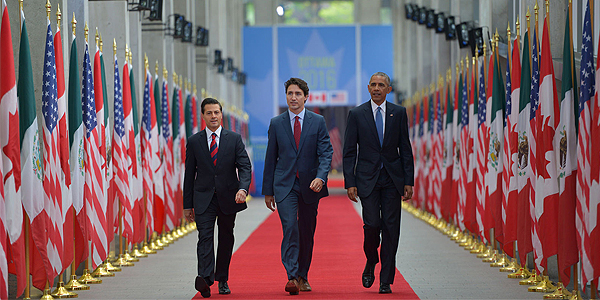Ruta de navegación
Menú de navegación
Blogs
Entries with label naphtha .
The positive consequences of the free trade agreement will derive more from the end of uncertainty than from the new provisions introduced.
After a year and a half of negotiations, the new treaty between the United States, Canada and Mexico (this country has named it T-MEC, the other two speak of USMCA) is still pending approval by the legislative chambers of each country. In Washington, the political discussion should begin shortly; it will be important what effects are foreseen for the US Economics and that of its two neighbors. The first programs of study disagree on some aspects, although they agree that the changes introduced in the renegotiation of the agreement that existed since 1994 will not have a special impact.
![signature of the U.S.-Mexico-Canada free trade agreement at framework of the G-20 in November 2018 [Shealah Craighead-White House]. signature of the U.S.-Mexico-Canada free trade agreement at framework of the G-20 in November 2018 [Shealah Craighead-White House].](/documents/10174/16849987/tmec-blog.jpg)
▲ signature of the U.S.-Mexico-Canada free trade agreement at framework of the G-20 in November 2018 [Shealah Craighead-White House].
article / Ramón Barba
The renegotiation of the formerly North American Free Trade Agreement (NAFTA, or NAFTA for its acronym in English) and now baptized as the Treaty of the United States, Mexico and Canada (T-MEC or, in its Anglo-Saxon version, USMCA), has been one of the main points on the Trump Administration's diary . C by the three negotiating parties at the end of 2018, now the treaty is pending ratification by the legislative chambers of each country.
Launched in 1994, the agreement had been described by Trump as "the worst trade agreement in history". From the beginning of his presidency, Trump set out to modify some aspects of agreement to reduce the large trade deficit with Mexico (some $80 billion, double the deficit the US has with Canada), and at the same time refund activity and jobs to the US Rust Belt, where the echo of his promises had been decisive for his electoral victory.
What has each country gained and what has each country lost in the renegotiation of the treaty? And, above all, what effects will it have on each country's Economics ? Will the United States improve its trade balance? Will Mexico or Canada be negatively affected by some of the modifications introduced? We will first examine how the claims of each of the partners were left at the end of the negotiations, and then we will look at the possible economic effect of the new version of the treaty in the light of two recent reports programs of study, one by an independent body of the U.S. Administration and the other by the IMF.
Tug of war
In the negotiations, which dragged on for nearly a year and a half, Mexico and Canada managed to "maintain the status quo in many important areas," but while the actual changes were modest, as analyzed by the Brookings Institution, they "went almost uniformly in the direction of what the United States wanted." "Trump's aggressive and threatening approach ," which challenged with breaking the treaty for good, "succeeded in obtaining modest concessions from his partners."
In the automotive industry core topic , the US managed to increase from 62.5% to 75% the proportion of the production of a car that must be made within the free trade area , to force 30% of the work needed to manufacture a car to have a wage of $16/hour (40% as of 2023) -a measure aimed at appeasing the US unions, since in Mexico the average wage of an automotive worker today is $4/hour-, and to set a tariff of 25% for cars coming from outside the country.
Mexico and Canada were granted their demand that an autonomous termination clause not be introduced after five years if there was no prior consensus for the renewal of the agreement, put on the table by Washington. Finally, the T-MEC will last for 16 years, renewable, with a review in the sixth year.
Justin Trudeau's government had to make some concessions to the U.S. dairy sector, but preserved what had been its main red line from the beginning: the validity of Chapter 19, concerning the settlement of disputes through independent binational arbitration.
Mexico, for its part, gained the peace of mind that comes with the survival of the agreement, avoiding future uncertainty and guaranteeing close trade relations with the large U.S. market. However, the labor conditions of Mexican workers can work as a double-edged sword for the Aztec Economics , since on the one hand it can favor an improvement in the standard of living and encourage consumption, but on the other hand it can affect the location of companies due to less competitive salaries.
Regardless of these changes in one direction or another, the update of the treaty was necessary after 25 years of a agreement that was signed before the Internet revolution and the digital Economics that it has brought. On the other hand, the change of name of the treaty was a "gimmick" devised by Trump to sell to his electorate the renewal of a agreement whose previous name was associated with criticisms made over the last two decades.
The discussion on the text will take place in the fall at the US congress , where Democrats will insist on strengthening assurances that Mexico will implement the committed labor measures. Prior to the vote the US must apply a exemption to Canada and Mexico of the steel and aluminum tariffs that the Trump Administration has imposed internationally.
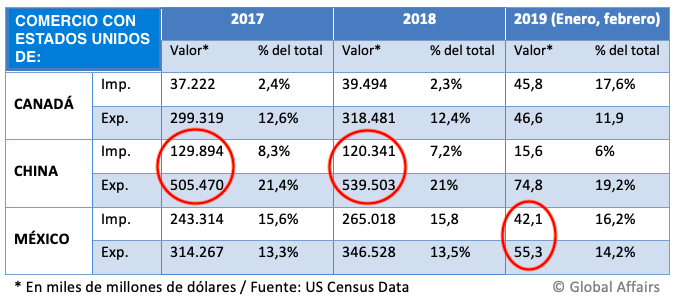 |
Economic effect
The United States International Trade Commission (USITC), an independent body that has the status of a government agency, considers that the T-MEC will have a limited but positive impact on the US Economics . Thus, in a report published in April, it estimates that the entrance in force of the reformulated agreement will increase US production by 0.35%, with an increase in employment of 0.12%, figures somewhat lower than those predicted when NAFTA came into force in 1994, when the US expected a 0.5% increase in its Economics and a 1% rise in employment.
In any case, this timid impact would not be so much due to the content of the agreed text, but to its mere existence, since it eliminates uncertainties about US trade relations with its two neighbors.
The report believes that the T-MEC will lead to an increase in the production of automotive accessories in the US, dragging up the employment in that country, but making the products more expensive and, therefore, negatively affecting exports. The report also foresees that maintaining the current arbitration system, as demanded by Mexico and Canada, will discourage US investments in the Mexican market and boost them in the US.
These conclusions do not coincide with the assessment of the International Monetary Fund, although both bodies agree with agreement in ruling out major effects of agreement. Thus, an IMF study published in March believes that, at the aggregate level, the effects of the new wording "are relatively small". The new provisions "could lead to less economic integration of North America, reducing trade among the three North American partners by more than $4 billion (0.4%), while giving their members combined gains of $538 million". It adds that the real GDP effects of the free trade area are "negligible," and qualifies that many of the benefits "would come from trade facilitation measures that modernize and integrate customs procedures to further reduce trade costs and border inefficiencies."
The result of the study sample that the more demanding rules of origin in the automotive sector and labor value content requirements, issues that especially concern the US-Mexico relationship, "would not achieve their desired consequences". According to the IMF, "the new rules lead to a decline in vehicle and parts production in the three North American countries, with shifts toward increased sourcing of vehicles and parts from outside the region. Consumers will find higher vehicle prices and will respond with lower quantity demand".
As for Canada's dairy market, an issue of particular relevance in the US-Canada trade relationship, the effects of increased US access "would be very small and macroeconomically insignificant".
This disparity in forecasts between the USITC and the IMF is due to the fact that several variables are undetermined, such as the future of the trans-Pacific agreement , in which Canada and Mexico are involved, or the ongoing trade discussions between the US and China. One sample where the ground is especially shaky is the data that in January and February 2019 Mexico became the first trade partner of the US (a exchange of $97.4 billion), ahead of Canada ($92.4 billion) and China ($90.4 billion). That raised the US trade deficit with Mexico by $3 billion, just in the opposite direction of the Trump Administration's claims.
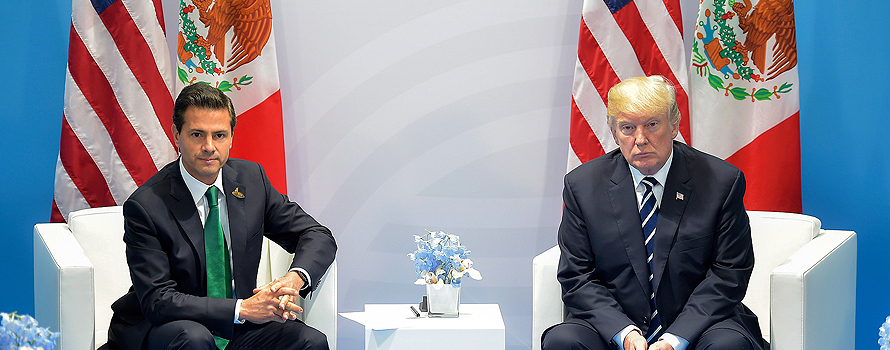
▲Presidents Enrique Peña Nieto and Donald Trump, in the latest G20 Summit; Hamburg, July 2017 [Presidency of Mexico].
ANALYSIS / Dania Del Carmen Hernández [English version] [Spanish version].
Canada, the United States and Mexico find themselves immersed in the renegotiation of the North American Free Trade Agreement (NAFTA). The trade treaty between these three countries has been controversial in the past few years, especially in the US, where many have doubted its benefits. During the presidential campaign, Donald Trump defended the complete elimination of the treaty; subsequently, when already in the White House, he agreed to make the renegotiation happen. President Trump argues that the pact has hollowed out US manufacturing and caused a trade deficit of over $60 billion with Mexico ($18 billion with Canada), so unless he can rework it in favor of the United States, he said, he won't hesitate to withdraw from it.
Overall, the American people have pretty positive views on the treaty, with 56% of the population who say that NAFTA is beneficial to the country, and just a 33% who say it's bad, according to a poll conducted by Pew Research in November 2017. Out of those who have a negative view, the majority are Republicans with 53% of them claiming Mexico benefits more, compared to Democrats who are generally more supportive of the trade pact and with just 16% who agree with the Republicans on that matter.
 |
Regardless of public acceptance, opinion on the treaty hasn't always been so dubious. When President Bill Clinton signed it into law, it was actually considered one of the first successes in his presidency. The same way globalization has liberalized trade all over the world, NAFTA effectively expanded trade and presented a great number of opportunities for the US, all while strengthening the country's economy.
Under NAFTA, US trade in goods and services with Canada and Mexico went from $337 billion in 1994 when the treaty came into force, to about $1.4 trillion in 2016. Under NAFTA, cross-border investment among the three member countries has surged as well, from $126.8 billion in 1993 to $731.3 billion in 2016.
The concern in Washington is that, despite of the increasing volume of trade, in relative terms the US isn't getting fruitful enough results, compared to what its neighbors are getting from it. In any case, Canada and Mexico accept that, almost after 25 years of validity, the agreement must be revised to be able to adapt it to the new productive and commercial conditions, defined by technological innovations that, as is with the case of the development of the internet, were not contemplated when the treaty was signed.
Round to round examination
The discussion between the three countries affects numerous aspects, but we can talk about three main blocks that have to do with certain network lines set by the different parties in the negotiation: rules of origin; the desire of the United States to end the independent system of arbitration, through which Canada and Mexico can terminate the measures that might violate the treaty (elimination of Chapter 19), and finally other proposals, perhaps less decisive but equally important, oriented towards the general wish to update the agreement.
When the negotiations started, in August 2017, the countries expressed a concern to reach a final decision in January 2018. The plan was to have six rounds of meetings. That number has been already overcome: a seventh round is happening at the end of February and there will be possibly more. As we have reached the initial deadline an examination on the state of the discussion is relevant. A good way of doing it is following the evolution of the conversations through the rounds of meetings celebrated and this way we can evaluate the results that have been registered so far.
|
Latest North America Summit, with Presidents Peña Nieto and Obama, and Prime Minister Trudeau; Canada, June 2016 [Presidency of Mexico]. |
1st Round (Washington, D.C.; August 16-20, 2017)
The first round of negotiations set the priorities for each of the three countries on the table; it served to fixate the diary of the principal issues that would be discussed later on, without going into much detail about the measures and the how- to's.
In the first place, Donald Trump had already set clear during his campaign that he considered NAFTA an unjust agreement for the United States, due to the trade deficit that the country has mostly with Mexico, and to a lesser extent, with Canada. According to the Office of the United States Trade Representative (USTR), the US went from a surplus of $1.3 billion in 1994 to a deficit of $64 billion in 2016. The major part of this deficit comes from the automotive industry. For the new administration, this puts in doubt that the treaty may have beneficial effects on American economy. Mexico, less predisposed to introduce important changes, insists that NAFTA has been good for all parties involved.
Another topic that was noted was Mexico's salary gap against the US and Canada. Mexico defends that, despite having one of the lowest minimum wages in South America, and having had their medium wage stuck during the two past decades, this shouldn't be taken into account in the negotiations, for it is estimates that Mexican salaries will eventually reach those of their commercial partners. On the contrary, for the US and Canada, this remains a matter of concern; both countries insist that a wage increase would not damage Mexican economy.
Rules of origin was one of the principal recurring topics of discussion. The United States is looking for augmentation in the percentage of content that is required to consider a product as of origin so that it won't be necessary to pay tariffs when moving it between the three countries. This proved to be rather controversial in this first round, as it could negatively affect Mexican and Canadian companies. Specialists have made the remark that a minimum of national content does not exist in any free trade treaties in the world.
Lastly, Trump's administration let their intentions of eliminating Chapter 19 show. A section of the treaty which guarantees equality in the solving of disputes between the countries, making it so that it isn't national laws what will dictate the outcome. The US understands it as a threat to their sovereignty and believes that conflicts should be resolved in a way in which their own democratic processes wont be ignored or jeopardized. For their part, Canada conditioned their permanence in the treaty with the maintenance of the chapter. Mexico also defends guarantees of independence in the resolution of conflicts even though for the moment it hasn't been categorical in this discussion, since it lingers on the side, and will act accordingly to what results most favorable.
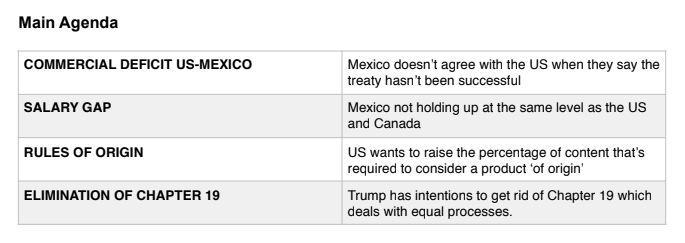 |
2nd Round (Mexico City; September 1-5, 2017)
Although considered successful by many analysts, the second round of the renegotiation followed a very slow pace. Some of the matters that made advances were: wages, access to markets, investment, investment, rules of origin, commercial facilitation, environmental issues, digital commerce, SME's, transparency, anti-corruption laws, agronomy and textiles.
The president of Corporate Coordinating Council in Mexico, Juan Pablo Castañon, insisted that for now the salary issue wasn't up for negotiation, and rejected the idea that any of the parties had the intention of pulling out of the treaty, despite the previous threats from the Trump administration. Castañon rallied in favor of Mexico supporting the maintenance of Chapter 19 or the establishment of a similar instrument with the purpose of solving commercial controversies amid the three countries.
3rd Round (Ottawa; September 23-27, 2017)
The delegates made important advances in competition policies, digital commerce, state-owned companies and telecommunications. The principal development had to do with some aspects related to SME's.
The Canadian chancellor, Chrystia Freeland, criticized that the United States had not made any written formal proposals on the most complex areas, demonstrating a passive attitude of the country in the context of the negotiation.
The US trade official, Robert Lighthizer, said that his country is interested in increasing the salaries in Mexico to avoid an unfair competence, seeing that Mexico has attracted factories and investments with their low salaries and their weak trade-union regulations.
Canada endured a firm posture on Chapter 19, which they consider one of the greatest achievements of the current agreement. "Our government is absolutely committed to defending it," said Freeland. Washington requested, though without presenting a formal proposal, the modification of the rules of origin so that they are more strict, avoiding that imports from other nations are considered "made in North America", just because they were assembled in Mexico.
This round took place while the United States fixed a tariff of almost 220% to the CSeries aircrafts by the Canadian manufacturer Bombardier, after considering that the enterprise had used a governmental subsidy to sell its plans to the United States at artificially low prices.
4th Round (Virginia; October 11-17, 2017)
The United States presented their formal proposal of elevating the rules of origin in the automobile industry and suggested introducing a termination clause in the treaty.
The US proposed raising the percentage of components of national origin from any of the three countries from 62.5% to 85% so that the production in the automobile industry can benefit from NAFTA. This way 50% of it will be American production.
It was also debated, in the interest of Washington, the weakening of the system of controversy resolution present in Chapter 19, which was done without registering an approximation of the positions.
To finish, they talked about a termination clause that would give the treaty five years of life and once that time was over, it would automatically disappear, unless, when the time came, the countries decided to renew it. This proposal received several critiques, many claiming that this could infringe the essence of the agreement and that every five years would generate uncertainty in the region, considering that it would affect the investment plans of companies.
These proposals just add to the harsh climax of the negotiation that had been present since the last round in which the US had started to defend difficult proposals like the trials for dumping (selling a product for a price below its normal price) in the imports of perishable Mexican products (tomatoes and berries, governmental and textile purchases.
5th Round (Mexico City; November 17-21, 2017)
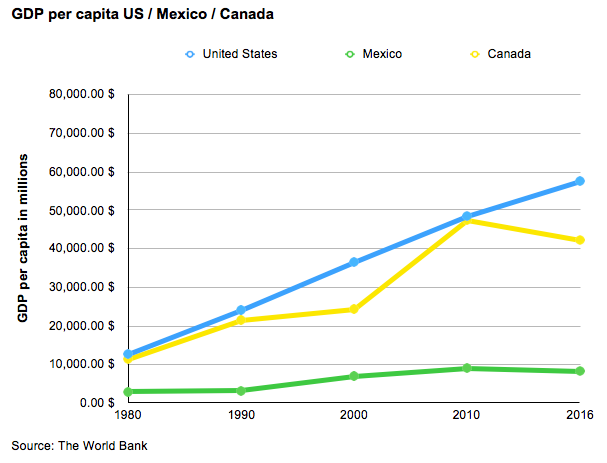 |
The fifth round didn't show too many advances. The United States kept their requests and that generated frustration amongst the representatives of Mexico and Canada.
The US didn't receive alternatives to its proposal to change the regional composition from a 62.5% to an 85%, and that at least 50% is American, On the contrary, its commercial partners showed the damage that this proposal could cause to the three economies.
Faced with the US' intentions to limit the number of concessions that their federal government offers to Mexican and Canadian enterprises, Mexican negotiators responded with a proposal to limit the country's public contracts to the number of the contracts attained by Mexican companies with other governments inside the NAFTA. Given that the number of those contracts is significantly reduced, US companies will see their contracting being restricted.
Upon completion of this fifth round, the topics that are now more developed are the ones that involve a regulatory enhancement of telecommunications and the chapter on sanitary and phytosanitary measures. With this last thing, Americans are looking to establish new transparent and non discriminatory norms, that will allow each country to establish the degree of protection they find appropriate.
6th Round (Montreal; January 23-29, 2018)
The Sixth Negotiation Round saw some progress. The chapter on corruption was finally closed, and progress was made in other fields. More importantly, we finally saw a discussion that involved some of the core issues that had been pushed back in the previous negotiations. The progression is slow, but steady.
Robert Lightizer rejected the compromise on rules of origin that Canada had previously proposed. The structure was based on the idea that the rules of origin should be calculated to also include the value of software, engineering and other high-value work, which is currently not counted toward the regional content targets. This would guarantee the safeguarding of high-paying jobs in the area. The US expressed its disapproval to the Canadian proposal. Mexico didn't find this surprising at all, as it already expected the cold shoulder from their American trade partner on this matter.
In another proposal, Canada made a threat as they claimed that they will keep the right to treat their neighbors worse than other countries if they enter into agreements. One of which could be China. The proposal was obviously not passed, as the US and presumably Mexico considered it 'unacceptable'.
Although the countries successfully worked towards installing measures against corruption during the round of negotiations, they were far from successful at reaching an agreement on the topic of modifying rules of origin and calculating the regional content of the country in which automobiles are manufactured. All three countries remain motivated to keep making progress and will resume the negotiations for a speculation of two more sessions before the deadline that has been set in March, in order to avoid interference with the presidential election in Mexico and the US midterm elections in November.
Beyond the deadline
After more than seven months of meetings, as we have seen in the round-by-round examination, the negotiations between the three countries still have not reached the pre-agreement threshold that, even waiting to resolve more or less important points, should confirm the shared will to give continuity to NAFTA. The hard positions of the United States and the pressure of Canada and Mexico to save the treaty have so far resulted in a 'tug-of-war' that has allowed some partial, but not decisive, result. Thus, it remains to be determined if the treaty has actually reached its expiration date or may be reissued instead. For the time being, the three countries agree to continue working towards a renewed treaty.
From what has been seen so far in the negotiations, it is difficult to determine which country will be more willing to give in to the pressure exerted by the others. The most controversial issues have barely been addressed until recently, so it is also not possible to point out what achievements each country achieves in this negotiating process.
The two neighbors of the United States, but especially Canada, continue to warn of Trump's risk to end the treaty. An acceleration of the negotiations could help the positive resolution of the process, but the electoral calendar rather threatens delays. On March 30 begins the campaign of the presidential elections in Mexico, which will take place on July 1. In September, the United States will begin to pay more attention to the November Mid-term elections. A substantial progress before the Mexican elections could put the agreement on track, although some issues should have to be agreed later, but if in the next meetings there is not a breakthrough, the three countries could get used to the possibility of ending NAFTA, what would harm the negotiations.
The neighbors of the United States in the Western Hemisphere find it difficult to interpret the first year of the new administration
Donald Trump reaches his first anniversary as president of the United States having caused some recent fires in Latin America. His rude disregard for El Salvador and Haiti, due to the high figures of refugees sheltered in the U.S., and his harsh treatment of Colombia, for the increase in cocaine production, had damaged relations. Although they were already complicated in the case of Mexico, throughout the year they had some good times, such as the presidents' dinner that Trump summoned in September in New York in which a united action was drawn on Venezuela.
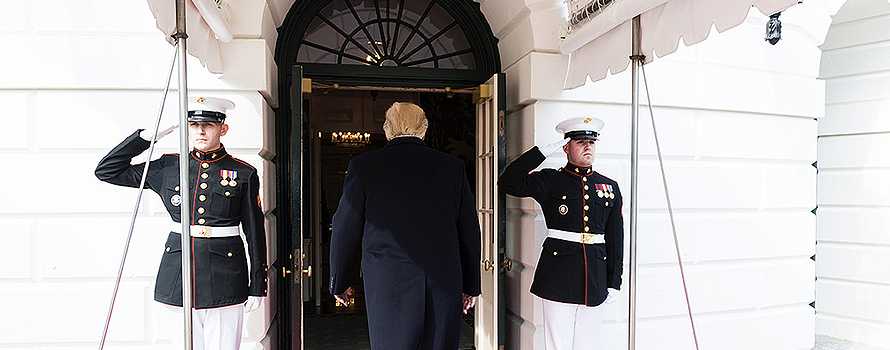
▲Trump in his first 100 days as president [White House].
ARTICLE / Garhem O. Padilla [English version] [Spanish version].
One year after the inauguration of the 45th President of the United States of America, Donald John Trump (the ceremony was on January 20), the controversy dominates the balance of the new administration, both in his domestic as well as international performance. The continental neighbors of the United States, in particular, show bewilderment about Trump's policies towards the hemisphere. On the one hand, they regret the American disinterest in commitments of economic development and multilateral integration; on the other hand, they note some activity in relation to some regional problems, such as the Venezuelan one. The actual balance is mixed, although there is unanimity that the language and many of Trump's forms threaten relationships.
From the TPP to NAFTA
In the economic field, the Trump era started with the definitive withdrawal of the United States from the Trans-Pacific Strategic Economic Partnership Agreement (TPP), on January 23, 2017. This made it impossible to enter into force since the United States is the market through which above all, this agreement emerged. The U.S. withdrawal affected the perspectives of the Latin American countries participating in the initiative.
Then, the renegotiation of the North American Free Trade Agreement (NAFTA), demanded by Trump, was opened. The doubts about the future of the NAFTA, signed in 1994 and that Trump has described as "disaster", have stood out in what is going of the administration. Some of its demands, which Mexico and Canada oppose, are to increase the share of products manufactured in the United States, and the "sunset" clause, which would force the treaty to be reviewed methodically every five years and suspend it if any of its three members did not agree. All this, arises from the idea of the U.S. president to suspend the treaty if it is not favorable for his country.
Cuba and Venezuela
If the quarrels with Mexico have not yet reached to an end, in the case of Cuba, Trump has already retaliated against the Castro regime, with the expulsion in October of 15 Cuban diplomats from the Cuban Embassy in Washington in response to"the sonic attacks" that affected 24 U.S. diplomats on the island. The White House, in addition, has revoked some conciliatory measures of the Obama administration because the Castro regime is not responding with open-ended concessions.
As far as Venezuela is concerned, Trump has made strong efforts in terms of introducing measures and sanctions against corrupt officials, in addition to addressing the political situation with other countries, so that they support those efforts aimed at eradicating the Venezuelan crisis, thus generating multilateralism between American countries. However, this policy has detractors, who believe that the sanctions are not intended to achieve a long-term objective, and it is not clear how they would promote Venezuelan stability.
Although in those actions on Cuba and Venezuela Trump has alluded to the democratic principles violated by the governors of Havana and Caracas, his administration has not insisted especially on the commitment to human rights, democracy and moral values, as being usual in the argumentation of the U.S. foreign policy. Some critics point out that the Trump administration is willing to promote human rights only when they meet its political objectives.
This could explain the worsening of the opinion that exists in Latin America about the United States and about the relations with that country. According to the Latinobarómetro survey 2017, the favorable opinion has fallen to 67%, seven points below that at the end of the Obama administration, which was 74%. This survey shows a significant difference for Mexico, one of the countries that, without a doubt, has the worst levels of favorable opinion towards the Trump administration: in 2017 it was 48%, which means a fall of 29 points in comparison with 2016, in which it was 77%.
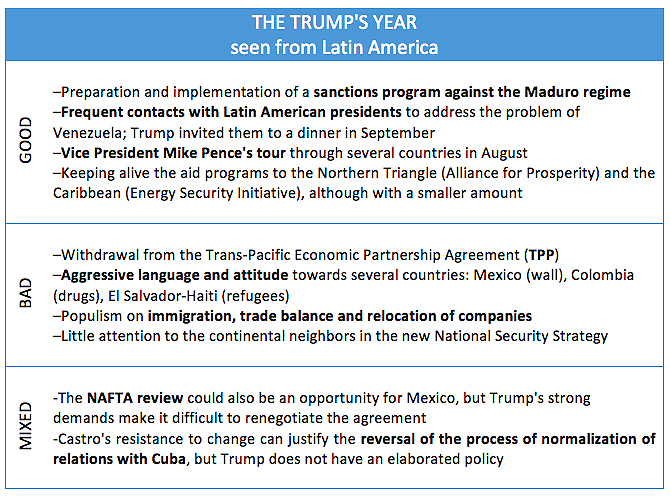 |
Immigration, withdrawal, decline
The restrictive immigration policies applied would also explain that rejection of the Trump administration by Latin American public opinion. In the immigration section the most recent is the decision not to renew the authorization to stay in the United States of thousands of Salvadorans and Haitians, who once entered the U.S. fleeing calamities in their countries.
We must also allude to Trump's efforts to achieve one of its main objectives since the beginning of his political campaign: to build a border wall with Mexico. The U.S. president has not had much success at this time, since although he has looked for ways to finance it, what he has managed to introduce in the budgets is very insignificant in relation to the estimated costs.
Trump's protectionism entails a withdrawal that may be accentuating the decline of the U.S. leadership in Latin America, especially against other powers. China has been increasing its economic and political performance in countries such as Argentina, Brazil, Chile, Peru and Venezuela. Russia, for its part, has strengthened diplomatic and security relations with Cuba. It could be said that, taking advantage of the conflicts between Cuba and the United States, Moscow has tried to keep the island in its orbit through a series of investments.
Threats to security
This leads us to mention the new National Security Strategy of the United States, announced in December. The document presented by Trump addresses the rivalry with China and Russia, and also refers to the challenge posed by the regimes of Cuba and Venezuela, by the supposed threats to security they represent and the support of Russia they receive. Trump expressed great desire to see Cuba and Venezuela join "shared freedom and prosperity" and called for "isolating governments that refuse to act as responsible partners in advancing hemispheric peace and prosperity."
Similarly, the new U.S. Security Strategy refers to other challenges in the region, such as transnational criminal organizations, which impede the stability of Central American countries, especially Honduras, Guatemala and El Salvador. All in all, the document only dedicates one page to Latin America, in line with Washington's traditional attention given to the areas of the world that most affect their interests and security.
An opportunity for the United States to approach the Latin American countries will be the Summit of the Americas, which will be held next March in Lima. However, nothing is predictable given the characteristic attitude of the president, which leaves a large open space for possible surprises.

